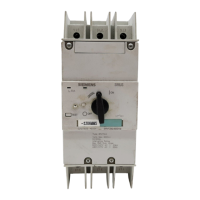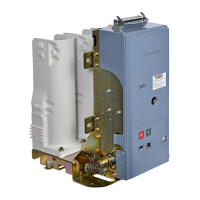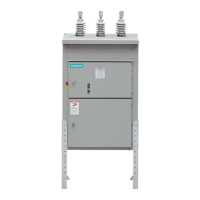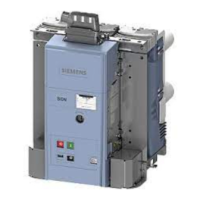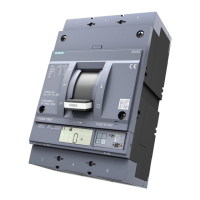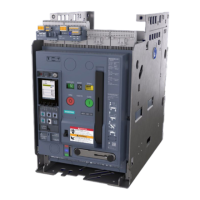Testing
o
Exitation
Test
The
purpose
of an exitation
test
is
to reveal shorted
turns
in
the
current
sensorwinding.
Sixty
(or50)
Hertz
ac voltage is applied
to the
secondarywinding
and the exciting
current
is
monitored.
Short circuit
turns will
be revealed
by excessive exciting
current and
possibly
by overheating
of the winding. A l20V
variable
transformer
(Variac)
and a
low
range ammeter is
all
that is required,
although
a 0-150 Volt ac voltmeter is
desirable
to monitor the
applied voltage. The
ammeter in the PTS4
test
set can be
used by
passing
current through the
external
current input.
ln
the absence
of a voltmeter the
dial
reading
on the variable
transformer
can be
used as an approximate voltage
indicator.
See table 5.
Table
5
Current Sensor
Exciting Current Test
Again each
phase
must be
tested in turn and the
trip device
must
be disconnected.
Connect the
ac supply to terminals l
and
5
for Phase
1, terminals
2 and 5 for Phase 2
and
from
terminals 3
and 5 for Phase
3.
The
output selector
switch can
be used to
select each
phase
when
the PTS4 test
set
is
used as the AC
ammeter, To test
the
ground
sensor or neutral
sensor
it is
necessary
to
have
the breaker in
the cubicle,
in
the
TEST
position.
Again
check the breaker wiring
diagram,
for any special
connections
that
may
have been made.
Table
5
gives
the
applied voltage and
test
limits
of exciting
current
for
all standard
current sensor ratings.
The value of .02
ampere is about
the
lowest
readable current
using the ammeters
in the PTS4
portable
test sets, and the
sensor that meets
this
limit
will
give
satisfactory
performance.
Normal
exciting currents for
sensors rated 400 amperes
and
above may
be well below
this
value.
Therefore when
checking high rating
sensors it is essential
to
perform
the
continuity
check. For the lower ratios
the continuity
check can
be omitted since
the indicated magnetizing
current would
verify
continuity.
Sensor
Polarity
Forthe
ground
fault
detection elements to operate
properly
the
sensors must be connected with
the
proper polarity.
Siemens
current
sensors and
ground/neutral
sensors are checked for
polarity
at the
factory
and terminals are marked with
a
polarity
dot. Therefore a simple
check
for
proper
connection according
to the breaker wiring diagram is
all that should
normally
be
required
to
verify
that the trip unit is receiving the correct
ground
fault signal.
lf there is doubt that
a
given
sensor is
properly
marked, its
polarity
can be checked by
"flashing"
the
primary
with
a short
duration
pulse
of known dc
polarity
and observing the
polarity
of the induced
secondary voltage on make and break of the
primary.
A 6 volt dry cellcan
be used
for
the
primary
source and
the
polarity
indicated by a dc voltmeter
connected to the
secondary winding. Refer
to the equipment one line or breaker
wiring diagram for
the correct
neutral
or
ground
return sen-
sor
polarity.
Primary
Current Testing
Testing with
primary
current applied to the circuit breaker
requires
a low voltage high
current supply that can deliver
currents up to 4 or 6 times the
sensor
rated
current.
There is
commercially
available equipment made for this
purpose,
This
equipment
generally
includes the ammeters and timers
needed
to fully test
the breaker.
Primary
current testing can
provide
the
ultimate
in
assurance
that the entire
protective
system is functioning
properly,
since
the entire system is
tested at one time. However
primary
current
testing may
present
additional
problems.
One
major
difficulty
arises from
the
non-linear
impedance of the trip device
power
supply circuit. This
circuit
is
designed to
provide power
to
operate at low levels
of current then change
impedance for
higher levels
of current to
protect
the
trip device.
When sup-
plied
from
a low voltage source this
changing
impedance
alters the waveshape
of the current supplied to the trip device.
This can result in insufficient
power
to
properly
operate
the tripped device, or it may affect the indication of the
source
ammeter, depending on the ammeter design,
lead-
ing to the erroneous assumption
that the trip device calibra-
tion is incorrect.
U
Sensor
Rating
Applied
Volts
(V)
120
Volt
Variac
Setting
Maximum
Exciting
Current
(A)
150
204
300
400
600
800
1200
& up
JJ,C
67
67
67
67
134
134
50
50
50
50
100
100
0.25
015
0.10
0.10
0.05
0.03
o.o2
ca
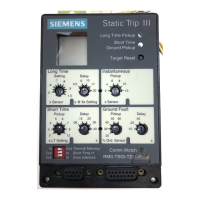
